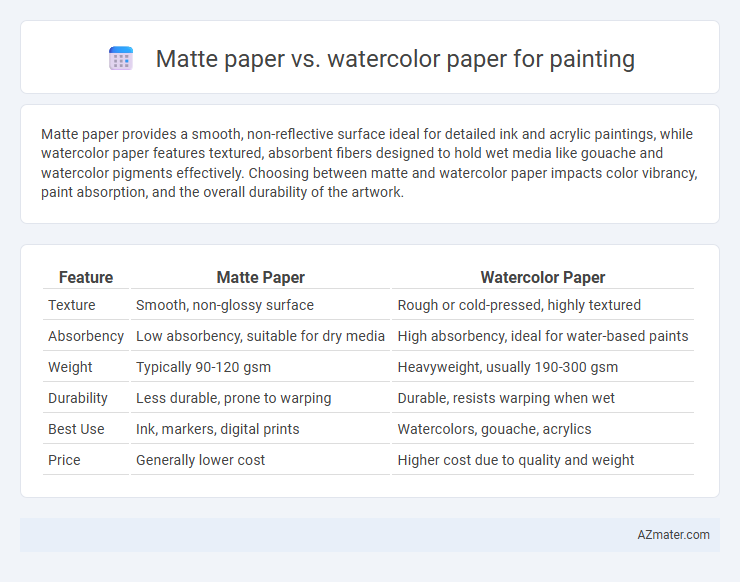Matte paper provides a smooth, non-reflective surface ideal for detailed ink and acrylic paintings, while watercolor paper features textured, absorbent fibers designed to hold wet media like gouache and watercolor pigments effectively. Choosing between matte and watercolor paper impacts color vibrancy, paint absorption, and the overall durability of the artwork.
Table of Comparison
| Feature | Matte Paper | Watercolor Paper |
|---|---|---|
| Texture | Smooth, non-glossy surface | Rough or cold-pressed, highly textured |
| Absorbency | Low absorbency, suitable for dry media | High absorbency, ideal for water-based paints |
| Weight | Typically 90-120 gsm | Heavyweight, usually 190-300 gsm |
| Durability | Less durable, prone to warping | Durable, resists warping when wet |
| Best Use | Ink, markers, digital prints | Watercolors, gouache, acrylics |
| Price | Generally lower cost | Higher cost due to quality and weight |
Introduction to Matte and Watercolor Paper
Matte paper features a smooth, non-reflective surface ideal for detailed ink drawings and digital prints, offering minimal texture that enhances color accuracy and sharpness. Watercolor paper is specially designed with a textured surface and high absorbency to handle wet media, preventing warping and allowing pigments to blend smoothly. Choosing between matte and watercolor paper depends on the painting technique and medium, as watercolor paper supports fluid washes while matte paper excels with dry media and fine lines.
Key Characteristics of Matte Paper
Matte paper features a smooth, non-reflective surface that enhances color vibrancy and detail precision, making it ideal for digital prints and fine art reproductions. Its non-porous texture resists ink absorption, resulting in crisp, sharp lines suitable for ink drawings and graphic designs. Matte paper typically has a heavier weight and durability, providing a sturdy base that minimizes warping or buckling during handling and display.
Unique Features of Watercolor Paper
Watercolor paper features a highly absorbent and textured surface designed to hold water and pigment effectively, preventing warping and ensuring vibrant color retention. Its heavier weight, typically ranging from 140 lb (300 gsm) or more, provides durability and stability suited for wet media. Unlike matte paper, watercolor paper's cold-pressed or hot-pressed finishes create unique textures that enhance brushwork and layering techniques for dynamic watercolor effects.
Texture and Surface Comparison
Matte paper offers a smooth, non-reflective surface ideal for detailed illustrations and ink work, but it lacks the absorbency and texture needed for vibrant paint effects. Watercolor paper features a textured, absorbent surface with varied options like cold-pressed or rough, which enhances pigment blending and paint layering for richer, more dynamic paintings. The heavier weight and tooth of watercolor paper provide superior durability and water retention, making it the preferred choice for wet media artists.
Absorbency and Paint Handling
Matte paper typically has lower absorbency compared to watercolor paper, resulting in slower paint drying times and increased risk of smudging, making it less ideal for wet media techniques. Watercolor paper is designed with higher absorbency and a textured surface that efficiently handles water-based paints, allowing for smooth blending and vibrant color retention. The superior paint handling properties of watercolor paper support layering and wash effects essential for detailed and dynamic watercolor artwork.
Suitability for Different Painting Mediums
Matte paper is ideal for acrylics and gouache due to its smooth surface that allows even paint application and vibrant color retention. Watercolor paper, with its textured surface and high absorbency, excels for watercolor and ink mediums by enabling controlled pigment dispersion and water flow. Artists should choose matte paper for opaque mediums and watercolor paper for fluid, transparent washes to achieve optimal results.
Durability and Longevity
Matte paper offers a smooth, non-reflective surface but often lacks the durability needed for long-term painting preservation compared to watercolor paper, which is specifically designed to withstand moisture and heavy pigment application. Watercolor paper typically contains high-quality cotton fibers, providing superior longevity and resistance to warping, yellowing, and deterioration over time. Choosing watercolor paper enhances the durability and archival quality of paintings, ensuring colors remain vibrant and the artwork maintains structural integrity for decades.
Cost and Accessibility
Matte paper is generally more affordable and widely available in art supply stores and general retail outlets, making it a cost-effective choice for beginners and casual painters. Watercolor paper, often pricier due to its specialized composition and texture, is essential for water-based mediums to prevent warping and absorb paint properly, which may limit accessibility for budget-conscious artists. Purchasing watercolor paper in bulk or opting for student-grade brands can help reduce expenses while maintaining adequate quality for practice or experimentation.
Best Uses for Matte Paper vs Watercolor Paper
Matte paper is ideal for artists seeking a smooth, non-reflective surface that enhances fine detail and vibrant color saturation, making it perfect for detailed illustrations and ink work. Watercolor paper, characterized by its textured, absorbent surface, excels in handling wet media and blending, making it the best choice for watercolor paintings and mixed media techniques. Choosing between matte and watercolor paper depends on the painting medium and desired texture, with matte paper suited for precision and clarity, while watercolor paper accommodates fluid brushwork and gradient washes.
Conclusion: Choosing the Right Paper for Your Art
Matte paper offers a smooth, non-reflective surface ideal for detailed work and mixed media, while watercolor paper provides superior texture and absorbency essential for vibrant washes and blending. Artists should select matte paper for crisp line work and controlled pigment flow, whereas watercolor paper suits fluid, layered painting techniques requiring durability and water absorption. Understanding the specific characteristics of each paper type ensures the best outcome for your artistic style and medium.

Infographic: Matte paper vs Watercolor paper for Painting
 azmater.com
azmater.com